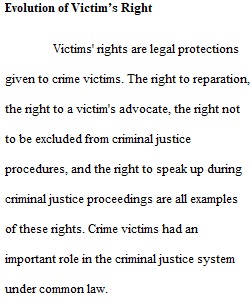


Q Overview In this assignment, you will reflect on how victims’ rights have evolved over time and whether they are currently effective in protecting victims and providing them with restitution. Prompt Now that you have reviewed several resources that discuss victims’ rights, you are familiar with the evolution of victims’ rights and how they vary slightly from state to state. For this journal activity, do the following: 1. Find your state’s list of victims’ rights. You should be able to locate them by entering into the search bar of your web browser the name of your state followed by “victims’ bill of rights.” For example, to find victims’ rights for the state of New Hampshire, you would enter “New Hampshire victims’ bill of rights.” (If you are having trouble finding your state’s list of victims’ rights, you may use this information for the state of Michigan.) 2. In a 350- to 500-word journal entry, briefly address each of the following: o How did victims’ rights evolve? o What were the key social movements of the 1960s and 1970s that impacted victims’ rights? o What are the victims’ rights that are common across all states? o Consider your state’s victims’ bill of rights. How are victims’ rights today effective or not effective at protecting victims from further harm and providing them with restitution? Provide one example and support your response with appropriate resources. Specifically, the following rubric criteria must be addressed: • Describe the evolution of victims’ rights. • Identify the key social movements of the 1960s and 1970s that impacted victims’ rights. • Identify the victims’ rights that are common to each state. • Evaluate your state’s victims’ rights for the extent to which they are effective or not effective at protecting victims from further harm and providing them with restitution. Provide one example. Guidelines for Submission This assignment must be 350 to 500 words in length. Any references must be cited in APA style. Consult the Shapiro Library APA Style Guide for more information on citations.
View Related Questions